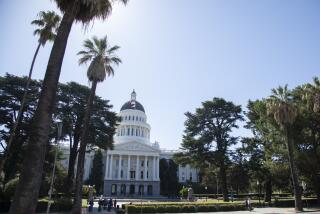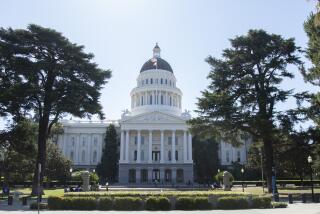Capitol dome could be a glowing example of energy efficiency
- Share via
WASHINGTON — How many lawmakers does it take to change a light bulb?
You may soon find out, thanks to an effort underway to illuminate the U.S. Capitol dome with more energy-efficient lighting.
The project stems from a push by House Speaker Nancy Pelosi (D-San Francisco) to make Congress a shining example of environmental responsibility. But like many projects in Washington, it is not without controversy. Republicans say the $1-million-plus price tag is too costly at a time of record federal budget deficits.
Jeff Ventura, a spokesman for the House chief administrative officer, said the lighting project had “far less to do with saving money in the short term on our energy bill . . . but has everything to do with setting a bold energy-saving example for the rest of the country.”
It was also crucial, he said, to put “what is arguably one of the best-known international symbols of democracy in the best light possible -- one that uses modern, energy-efficient . . . technology to honor the grandeur and splendor of the building’s architecture and history.”
But doing so isn’t as simple as changing the bulbs. A lighting consultant was hired, at a cost of $671,900, to come up with a system that would not only save energy but also celebrate the Capitol’s “unique identity” and “enliven the visual experience” of all those who view it, according to the House posting for a consultant.
The dome’s exterior currently is lighted by 38 1,000-watt metal halide lamps that were installed 20 years ago. They will be replaced by 128 lighting fixtures. But with the new bulbs ranging from 35 watts to 210 watts -- and with advancements in technology -- the project’s designer expects the lighting to use 70% less energy.
The top of the dome first was illuminated during the 19th century with gas lamps, according to the office of the Architect of the Capitol. Electric lighting arrived in time for President Wilson’s second inauguration in 1917.
The Capitol was lighted every night during World War I to “inspire the patriotic sentiments of visitors and troops passing through the city,” but the dome was blacked out during World War II.
The lights also were turned off briefly during the 1973 energy crisis.
Helen K. Diemer, president of the Lighting Practice, the Philadelphia-based consulting firm hired for the dome project, said: “We were asked to look at the other monuments and design the lighting of the Capitol in a way that would be in keeping with the hierarchy of buildings and monuments on the mall, with the Capitol being the most prominent.”
Replacing the dome’s lighting system is the centerpiece of Pelosi’s Green the Capitol initiative -- which has introduced biodegradable utensils and compostable containers in the House cafeterias. The menus in the House members’ dining room are printed on recycled paper.
Some Republicans, however, have questioned whether the lighting project is worth the cost.
House Minority Leader John A. Boehner (R-Ohio) complained that it would take 50 years to generate enough energy savings to recoup the costs.
And Rep. Kevin McCarthy (R-Bakersfield) said: “I fully support projects that actually result in greater energy efficiency within the Capitol complex. But I strongly believe at a time of record national debt, the people’s House should prioritize [how it uses] the people’s money.”
The project, more than a year behind schedule, could get underway next summer.
Previous efforts to make Washington more eco-friendly have met with mixed results.
For example, President Carter had solar panels installed on the White House roof. The Reagan administration had them removed.
--
More to Read
Sign up for Essential California
The most important California stories and recommendations in your inbox every morning.
You may occasionally receive promotional content from the Los Angeles Times.














